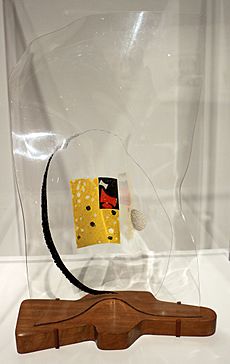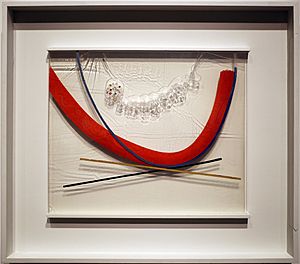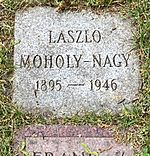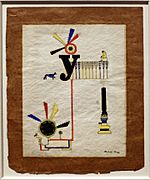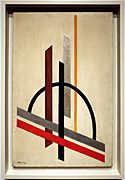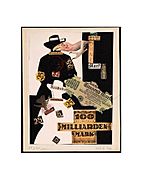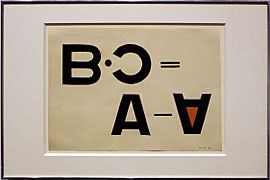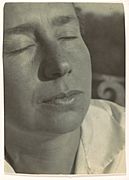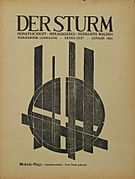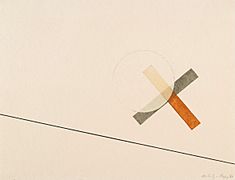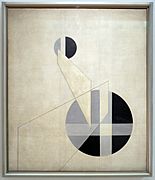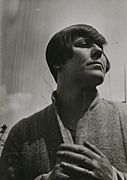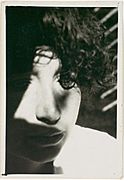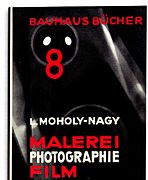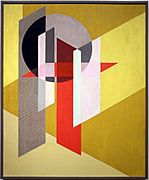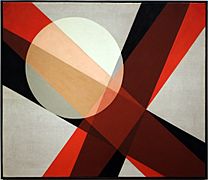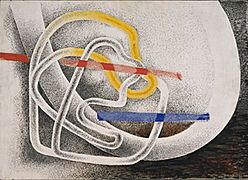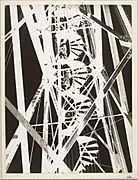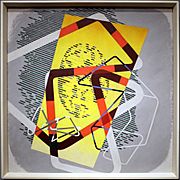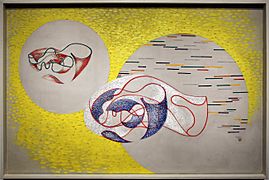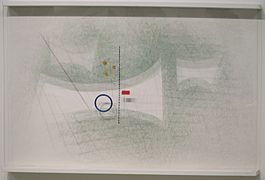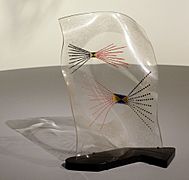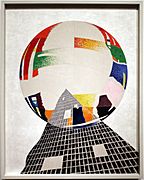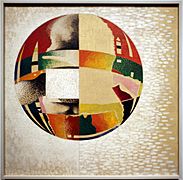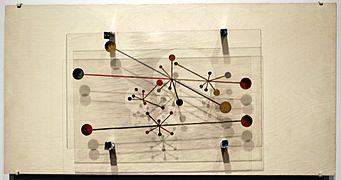László Moholy-Nagy facts for kids
Quick facts for kids
László Moholy-Nagy
|
|
|---|---|

Declaration of Intention for US citizenship (1938)
|
|
| Born |
László Weisz
July 20, 1895 Bácsborsód, Austria-Hungary
|
| Died | November 24, 1946 (aged 51) Chicago, Illinois, US
|
| Resting place | Graceland Cemetery |
| Nationality | Hungarian American (1946) |
| Known for | Painting, photography, sculpture, film |
|
Notable work
|
Light Prop for an Electric Stage (1928–1930, also called Light-Space Modulator posthumously) |
| Style | Constructivism |
| Movement | Bauhaus |
| Spouse(s) |
|
László Moholy-Nagy (born László Weisz; July 20, 1895 – November 24, 1946) was a talented Hungarian artist. He was a painter, photographer, and a teacher at the famous Bauhaus school.
Moholy-Nagy was greatly inspired by a style called Constructivism. This art movement used simple shapes and industrial materials. He strongly believed that art should use new technology and ideas from factories. One art critic called him "always experimenting" because he tried so many different art forms. These included painting, drawing, photography, collage, sculpture, film, and writing.
He often worked with other artists, like his first wife Lucia Moholy. His biggest achievement was starting the School of Design in Chicago. This school is still open today as part of the Illinois Institute of Technology. Moholy-Nagy also wrote books and articles about his ideas for modern art.
Contents
Early Life and Learning (1895–1922)
László Moholy-Nagy was born László Weisz in Bácsborsód, Hungary. His family was Jewish. When he was young, his father left the family.
His uncle, Gusztáv Nagy, helped support László and his younger brother, Ákos. László later took his uncle's last name, Nagy. He also added "Moholy" to his name, after a town called Mohol where he spent some of his childhood.
László went to a gymnasium (a type of high school) in Szeged. At first, he wanted to be a writer or poet. Some of his poems were even published in newspapers in 1911. In 1913, he started studying law at the University of Budapest.
During World War I, in 1915, he joined the army as an artillery officer. While serving, he drew pictures and wrote about his experiences. He was hurt in 1917 and recovered in Budapest. After leaving the military in 1918, he stopped studying law. He then went to an art school taught by the Hungarian artist Róbert Berény.
In 1919, he moved to Vienna, and then to Berlin in early 1920. In Berlin, he met a photographer and writer named Lucia Schulz. They got married in 1921.
In 1922, Moholy-Nagy met Walter Gropius at an art show. That summer, he and Lucia experimented with making photograms. This is a way of making pictures without a camera, by placing objects on special paper and exposing it to light. He also started planning his famous sculpture, the Light-Space Modulator.
Teaching at the Bauhaus (1923–1928)
In 1923, Walter Gropius invited Moholy-Nagy to teach at the Bauhaus school in Weimar, Germany. He became a co-teacher for the main art course and led the Metal Workshop. His arrival helped the Bauhaus focus more on design and connecting art with industry.
The Bauhaus was known for its artists who could do many things, and Moholy-Nagy was a great example. He became skilled and creative in photography, typography (designing text), sculpture, painting, printmaking, filmmaking, and industrial design.
Photography was one of his main interests. He was guided by his first wife, Lucia Moholy, who was a skilled photographer. In his books, he used the term Neues Sehen (New Vision). This meant he believed cameras could show the world in new ways that the human eye couldn't see. This idea shaped his art and his teaching.
Moholy-Nagy was one of the first artists to suggest using scientific tools like telescopes, microscopes, and X-rays to create art. He and Lucia experimented with photograms, which are images made by placing objects directly onto light-sensitive paper. His teaching covered many different art forms, including painting, sculpture, photography, and metalworking.
Life During the Depression (1929–1937)
Moholy-Nagy left the Bauhaus in 1928 and started his own design studio in Berlin. He and Lucia separated in 1929.
A famous work by Moholy-Nagy is the Light Prop for an Electric Stage (1928–1930). This was a machine with moving parts that projected light. It created changing light reflections and shadows on nearby surfaces. It was later called the Light-Space Modulator. This was an early example of kinetic sculpture, which is art that moves. He used industrial materials like shiny metals and Plexiglas. He was more interested in the light patterns it made than how the machine looked itself. This makes it one of the first examples of Light art. He continued to create similar works in the 1940s.
Moholy-Nagy was also the photography editor for an art magazine from 1927 to 1929. He designed sets for plays and operas, created exhibitions, designed books, and made films. His studio employed other artists and designers.
In 1931, he met Sibylle Pietzsch, an actress and writer. They married in 1932 and had two daughters. Sibyl worked with him on a classic film called A Lightplay: Black White Gray, which was based on the Light-Space Modulator. She also helped him with other films and stayed with him for the rest of his life.
When the Nazis came to power in Germany in 1933, Moholy-Nagy, being a foreign citizen, could no longer work there. He moved to the Netherlands in 1934 for commercial work, then to London in 1935.
In London, he joined a group of artists and thinkers who had also moved from other countries. Moholy-Nagy tried to start an English version of the Bauhaus with Walter Gropius, but they couldn't get enough support. He also didn't get a teaching job at the Royal College of Art.
To make a living in London, Moholy-Nagy took on various commercial design jobs. He photographed modern buildings for a magazine and made documentary films. He also started painting on clear plastics like Perspex.
In 1936, a film producer asked him to design special effects for the movie Things to Come. Moholy-Nagy created moving sculptures and abstract light effects for the film, but most of them were not used by the director.
In 1937, his artworks were shown in a famous "Degenerate art" exhibition in Munich, organized by Nazi Germany. This exhibition was meant to criticize modern art.
Chicago Years (1937–1946)
In 1937, Moholy-Nagy moved to Chicago, USA. He was invited by Walter Paepcke, a business leader, to become the director of the New Bauhaus. The school's ideas were similar to the original Bauhaus.
However, the school lost its funding after only one year and closed in 1938. Moholy-Nagy went back to doing commercial design work, which he continued for the rest of his life. He also worked as an art advisor for a mail-order company.
Paepcke continued to support him, and in 1939, Moholy-Nagy opened the School of Design in Chicago. He also started making sculptures from clear plastic and chromed metal.
In 1943, Moholy-Nagy began writing about his work to create the School of Design's curriculum. This book, Vision in Motion, was published after his death in 1947, with help from his wife Sibyl.
In 1944, the School of Design in Chicago became the Institute of Design. In 1949, it joined the Illinois Institute of Technology. This was the first place in the U.S. to offer a PhD in design.
Moholy-Nagy was diagnosed with leukemia in 1945. He became an American citizen in April 1946. He kept creating art, teaching, and attending conferences until he passed away from the disease in Chicago on November 24, 1946. He was buried at Graceland Cemetery.
Legacy
The Moholy-Nagy University of Art and Design in Budapest is named in his honor. A software company, Laszlo Systems, was also partly named after him. In 1998, the City of Chicago placed a special marker to honor him.
In 2003, the Moholy-Nagy Foundation was created to share information about his life and art. In 2016, the Solomon R. Guggenheim Museum in New York held a large show of his work. This show included his paintings, films, photographs, and sculptures. In 2019, a documentary film called The New Bauhaus was released. It focuses on Moholy-Nagy's life and his school in Chicago.
Gallery
See also
 In Spanish: László Moholy-Nagy para niños
In Spanish: László Moholy-Nagy para niños
- Artificial obsolescence
- Lumino kinetic art
- Otto Piene – kinetic sculptor directly inspired by Moholy-Nagy's work, including Light-Space Modulator



